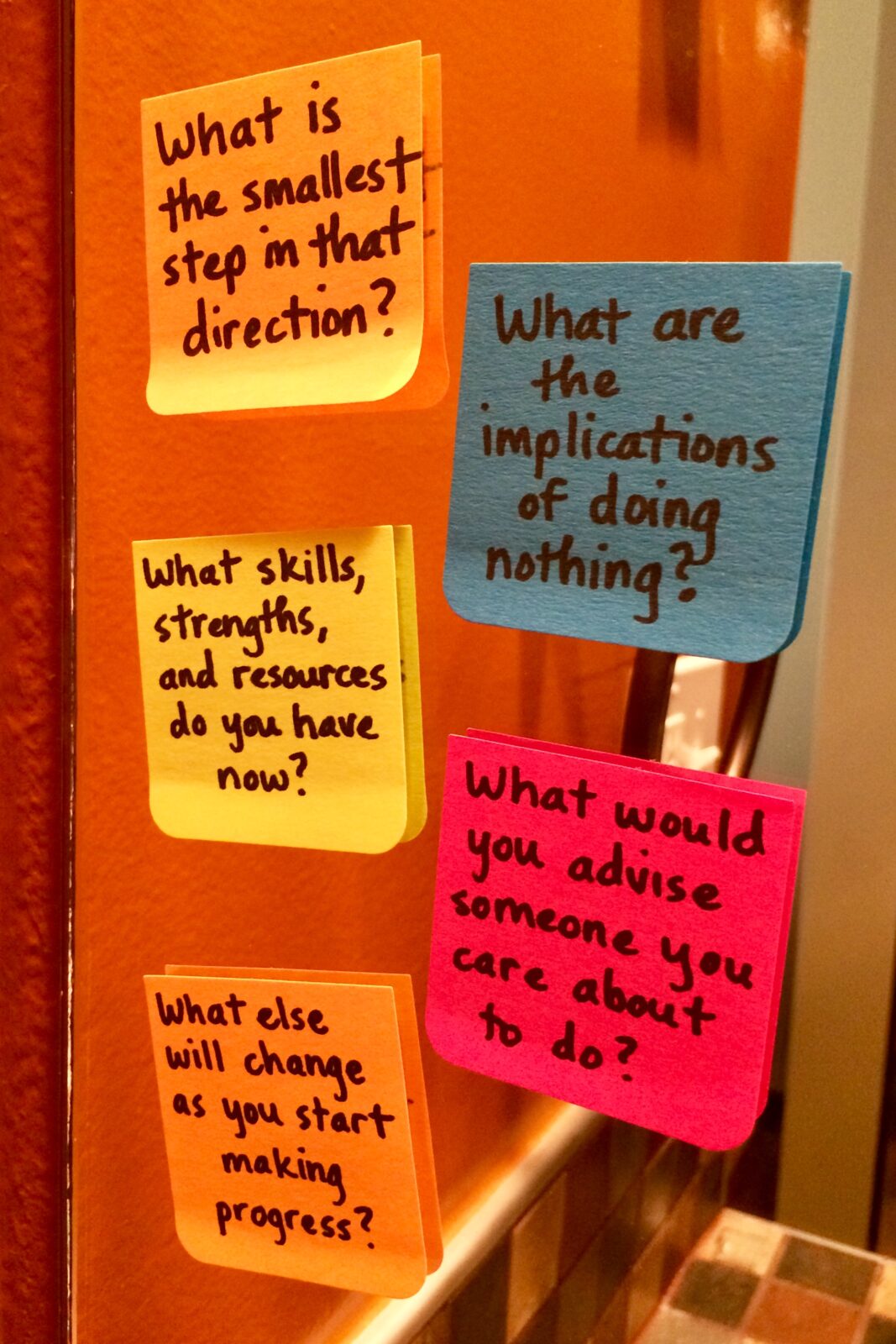
5 Powerful Communication Tips from Professional Coaching
[Kim Menig joined the Happy Brain Science team in 2018. She brings 15+ years of experience in nonprofit program management. She’s an International Coach Federation (ICF) member.]
Coaching: Crossover Thrills & Skills
Have you ever met with a personal, professional, or executive coach (or wondered what it would be like)? Or have you ever thought about becoming a coach yourself? If so, you probably know it can be meaningful—and even downright transformative—to participate in a process that’s designed to maximize our human potential. That’s what drew me to enroll in an accredited coach training program. I’m at the halfway point, and I’d love to share 5 powerful communication tips that are transforming me into a better communicator. But first…
What if I explode?!
“I’ve never wanted to give advice so badly in my entire life.” That was the burning thought I had the first time I coached a classmate in my program. Of course, I know most people aren’t exactly thrilled to receive unsolicited advice (myself included!). On top of that, one of the first things we learned in the program is that the style of coaching we practice is not about giving advice. But there was something about being in a role where I had to avoid it that it made it feel irresistible.
“Is becoming a professional coach going to ruin my personal life?” I wondered. Would coaching turn me into a pressure cooker of pent-up advice that would erupt into conversations with family and friends? Would I become a spewing geyser of “helpful” suggestions no one wanted?
Although my partner might tell a different story (and if so, he can write his own post), I believe the effect has actually been the opposite. Training as a coach has given me new insights and awareness for helping other people work through challenges. Whether I’m talking with a colleague or a loved one, I’ve got some excellent tools for supporting others when they’re processing their experiences and moving toward their desires. The mindset I’m developing has helped me cultivate a different way of showing up in conversations—and I’m less likely to choose advice as a starting point.
Here’s the big reason why: a coach assumes that the person they’re coaching is whole, resourceful, and the expert in their own life.
Isn’t that liberating? I can’t possibly know all the details that have gotten another person to this moment in their life. Not to mention that their very existence means they’re already doing a bunch of smart, adaptive things to navigate the world as they experience it.

There’s also a second reason: the insights we reach for—and arrive at—ourselves are most likely to inspire us to make the changes we crave.
That’s not to say we don’t need to seek out relevant resources, integrate feedback and mentoring, and learn as much as we can from books, trainings, and the wisdom of other people (and memes). It’s just that the way we synthesize those learnings is unique to each of us. A skillful coach creates an environment in which a person can take stock of what they know, increase their awareness and accountability, and stretch to make personal connections that open up new possibilities.
I’m excited to have the opportunity to focus on coaching as a profession. That said, we all have the ability to use coaching strategies to help each other clarify our goals and reach our potential. And I strongly believe the world gets a little (or a lot) better when we do. Here are 5 communication tips to consider when you’re supporting someone else’s efforts to work through an issue:
5 Communication Tips for Supporting Others:
1. Ask open-ended questions that start with “What…?”
2 major benefits that come from asking “What” questions:
- You avoid asking “why.” It’s counter-intuitive, I know—it seems so helpful to ask “why” to uncover someone’s motivation and thought process. But there’s nothing like a “why” question to accidentally make someone defensive…or get them started on an explanation that entrenches their current thinking.
- It’s pretty hard to ask a “What” question that’s not open-ended. Anytime you ask a closed, yes-or-no question, you’re creating an either/or choice that may not resonate for the other person. Conversely, a “What” question leaves room for multiple paths to emerge.
The best “What” questions avoid adding extra words. Extra words might frame an issue in a way that doesn’t accurately represent the other person’s thinking. For instance, after someone describes a situation they’re wrestling with, instead of asking them, “What techniques have you already tried to make your partner recognize the universal truth of your unsolicited advice?” you might pare it down to, “What have you already tried?” Less is more, so the other person can interpret the question in the way that’s most relevant to them.
2. Ask questions that emerge from attentive listening.
First, let me just say that coach training involves becoming familiar with tons of possible questions. My bathroom mirror has 54 Post-its on it (I just counted), each with a question that might be useful at a particular coaching moment. There are some really good ones: What’s important to you about this issue? If you had that insight, what (if anything) would change for you? What are some ways you could go about that? What resources or support would you need to make that happen?
As a coach, it’s easy to fall into the trap of trying to plug in the “right” question to any given coaching situation. And here’s the secret: there’s no such thing. The most powerful question—the one that’s most likely to facilitate an internally-driven perspective shift for another person—comes from active, reflective listening. You have to let go of trying to sound cool or clever. You can’t get attached to the hope that any given phrasing will create a breakthrough for the other person. The most effective thing you can do is really listen, and keep being present, in a way that’s alert-but-relaxed. When your question arises authentically from paying attention to the other person, you maximize the chances that they’ll be able to use it to move their own thinking forward.
3. Validate, then ask questions that move toward the desired goal.
When someone is struggling with an issue, it’s not unusual for them to spend time describing everything that’s wrong. Sometimes, just getting to express what’s going on can be illuminating. If they seem to be actively processing the issue, the best thing to do is not interrupt. When they reach a natural pause, it can also be valuable to reflect back the key themes you heard. (And it’s ideal to follow that up with a question like, “How does that resonate with you?” so the other person feels free to clarify or modify your summary.) At other times, though, it can seem like they’re talking in circles and just getting more frustrated. Especially when a person seems stuck, it can be effective to offer a question that changes the focus from what’s going wrong to what their desired outcome would be.
This happened for me recently when I was being coached by a classmate. I spent a solid 10 minutes talking about everything I was dissatisfied about, and at the end, I didn’t have any better ideas about what to do next. My classmate said, “It sounds like this situation is pretty frustrating right now. What would you like it to feel like?” I had to stop and think. I had been so wrapped up in what was wrong that I hadn’t thought to identify what I wanted. It’s much easier to come up with action steps when you have a clear vision of what success means to you. And the more richly envisioned your goal is, the better: what would your ideal experience look like, feel like, taste like?
4. Pay attention to big-picture clues.

You can’t actually “get inside” another person’s brain. And that’s a good thing! The advantage of not being enmeshed in another person’s perspective is that you have the ability to “zoom out” a little and notice larger patterns. For example, you can pay attention to whether the person uses certain words and phrases repeatedly. You can notice the metaphors and images they choose to describe their situation. Most importantly, you can observe changes in their non-verbal cues: the way their voice sounds, the expression on their face, their body language, etc.
Fortunately, you don’t have to be an expert in body language in order to correctly interpret what those changes mean. You just have to hold up a non-judgmental mirror for the other person. It can facilitate new awareness to say something like, “I noticed that your energy really increased just now when you talked about XYZ. What did you feel in that moment?” Or, “I noticed you used the phrase ‘feeling attacked’ a few times. What comes up for you when I say that?” As always, be prepared for the possibility that your observation might not lead to a new insight for the other person. However, by sharing it in a neutral and respectful way, it allows the other person to consider it and proceed as they see fit.
5. Avoid secret agendas.
Remember my first time coaching a classmate? I had a very strong urge to share my advice—I mean, I knew the answer to their problem! It was so clear! But I wasn’t there to give advice. (Offering advice is an important part of consulting, mentoring, and training—but the style of coaching I’m learning takes a different approach.) In communication settings where your intent is for the other person to direct the conversation, a paradox emerges. There are times when being fully present means sharing something directly so you don’t (even unconsciously) keep guiding the conversation in the direction you think it should go.
Here are 3 tips I’ve learned for doing this well:
- First, be honest with yourself about whether sharing your perspective will benefit the other person, versus whether you can let it go and refocus on them. An example when you shouldn’t let it go is when your perspective is grounded in concern for the person’s safety, or when you know a particular action could put a person in legal jeopardy, etc. An example when you probably should let it go is when you find yourself trying to solve their problem, even though they haven’t asked for that. (My coaching instructor offered a tip for this. If you find yourself leaning forward, and your stomach and/or shoulders are tight—you may be trying to “fix” the problem yourself. Relax and lean back.)
- Second, ask permission before sharing a perspective that might touch on a sensitive topic or come across as contradictory. This puts the power in the other person’s hands to decide what level of feedback they’re open to. It also helps them be better prepared (and more receptive) if they decide they’re willing to hear something challenging.
- Finally, ask something like, “What’s your take on that?” or “How do you see it?” This gives them an opportunity to decide what the information means to them and what they want to do next.

Exploring Coaching
Those are the most helpful communication tips I’ve discovered so far from the world of coaching! They’re not the right fit for every situation—but they’re valuable tools to have in your conversational toolbox. Since I’m still in training, I’m sure my understanding will continue to evolve, so please take everything here with a grain of salt. Of course, my understanding will keep evolving well beyond the timeframe when I complete my training. I expect it will be a lifetime process of learning and growing!
One of the most important ways I’ll grow is by actively coaching—which is why I’m officially offering coaching services, at a significantly discounted rate.
If you’d like to explore whether coaching might help you reach your goals, I’d love to hear from you so we can schedule a free, confidential conversation. Either way, I’ll share a blog post with what I’ve learned by the end of my coaching program in early August. Thanks for staying tuned!
Have you coached someone (formally or informally)? Or have you received helpful coaching? What was it like, and what worked well? I’m so interested to hear about other people’s experiences—thanks for anything you feel like sharing in the comments!
